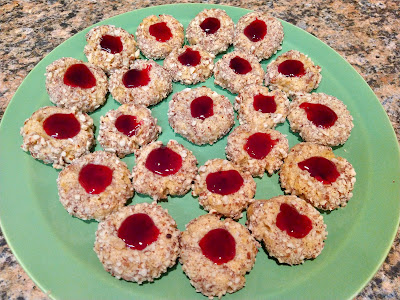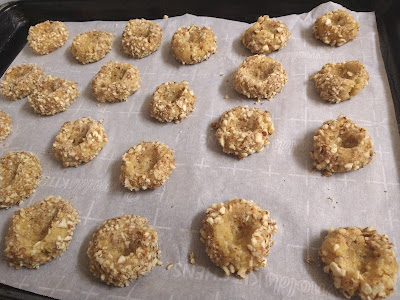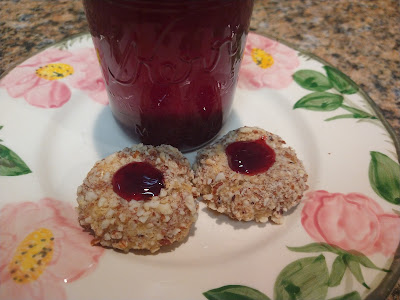
Recipe: These thumbprints are a twist on a traditional favorite

Pomegranate jelly glistens in almond thumbprints.
(Photos: Debbie Arrington)
|
When I’m lucky enough to have a good crop of pomegranates, I make pomegranate jelly.
What do you do with pomegranate jelly? Try it in thumbprints.
Besides the usual jelly things (such as on top of toast or to glaze meat), sweet-tart pomegranate jelly has a special asset during the holidays: Its beautiful red color.
In a traditional thumbprint cookie, pomegranate jelly glistens like ruby glass. It’s also a pretty and tasty touch to other filled cookies such as Valentine’s Day hearts.
The combination of pomegranate and almonds make these thumbprints very Central Californian, too. These are both tastes of our Valley.
Got pomegranates? Here’s my jelly recipe: https://sacdigsgardening.californialocal.com/article/11079-pomegranate-jelly-colors-the-season/
As for the thumbprints, use your first knuckle instead of your thumb to create a deeper well for the filling. While baking, that hole will get smaller as the cookie dough expands.
Warming the jelly makes it easier to spoon into those little holes.

Use a knuckle rather than thumb to indent the cookies
produces a deeper well for the jelly. The wells shrink
when the cookies are baked.
|
Pomegranate-almond thumbprints
Makes 2 dozen cookies
Ingredients
¼ cup butter, softened
¼ cup shortening
¼ cup golden brown sugar, packed
2 eggs, separated
½ teaspoon vanilla
1 cup all-purpose flour
¼ teaspoon salt
¾ cup almonds, finely chopped
¼ cup pomegranate jelly
Instructions:
Preheat oven to 350 degrees F.
With a pastry blender or fork in a large bowl, blend together butter and shortening. Add brown sugar, egg yolks and vanilla.
Sift together flour and salt. Add flour mixture gradually to bowl, working it into the butter mixture to create a soft dough.
Roll dough into balls, 1 tablespoon of dough at a time. (Refrigerate dough if it gets too soft and sticky.) Balls will be a little over an inch wide in size.
Cover cookie sheet with parchment paper (optional). Otherwise, use an ungreased cookie sheet.

Pomegranate jelly glistens in these cookies, which also would
be good to bake for Valentine's Day.
|
Beat egg whites lightly. Roll each ball in egg white, then in chopped almonds. Space balls about 2 inches apart on cookie sheet. With your knuckle, gently press down in center of each ball to create a well and flatten the cookie.
Bake at 350 degrees for 10 to 12 minutes. (Don’t bake too long; they’ll get hard!) Cookies will be lightly browned. Remove promptly from cookie sheet. Let cool.
Warm pomegranate jelly in microwave on MEDIUM for 10 to 15 seconds. Stir. Spoon about ½ teaspoon of jelly into each cookie. Let cool.
Comments
0 comments have been posted.Sacramento Digs Gardening to your inbox.
Food in My Back Yard Series
May 6: Maintain soil moisture with mulch for garden success
April 29: What's (already) wrong with my tomato plants?
April 22: Should you stock up on fertilizer? (Yes!)
April 15: Grow culinary herbs in containers
April 8: When to plant summer vegetables
April 1: Don't be fooled by these garden myths
March 25: Fertilizer tips: How to 'feed' your vegetables for healthy growth
March 18: Time to give vegetable seedlings some more space
March 11: Ways to win the fight against weeds
March 4: Potatoes from the garden
Feb. 25: Plant a fruit tree now -- for later
Feb. 18: How to squeeze more food into less space
Feb. 11: When to plant? Consider staggering your transplants
Feb. 4: Starting in seed starting
Sites We Like
Garden Checklist for week of May 4
Enjoy this spring weather – and get gardening!
* Plant, plant, plant! It’s prime planting season in the Sacramento area. Time to set out those tomato transplants along with peppers and eggplants. Pinch off any flowers on new transplants to make them concentrate on establishing roots instead of setting premature fruit.
* Direct-seed melons, cucumbers, summer squash, corn, radishes, pumpkins and annual herbs such as basil.
* Harvest cabbage, lettuce, peas and green onions.
* In the flower garden, direct-seed sunflowers, cosmos, salvia, zinnias, marigolds, celosia and asters. (You also can transplant seedlings for many of the same flowers.)
* Plant dahlia tubers. Other perennials to set out include verbena, coreopsis, coneflower and astilbe.
* Transplant petunias, marigolds and perennial flowers such as astilbe, columbine, coneflowers, coreopsis, dahlias, rudbeckia and verbena.
* Keep an eye out for slugs, snails, earwigs and aphids that want to dine on tender new growth.
* Feed summer bloomers with a balanced fertilizer.
* For continued bloom, cut off spent flowers on roses as well as other flowering plants.
* Add mulch to the garden to maintain moisture. Mulch also cuts down on weeds. But don’t let it mound around the stems or trunks of trees or shrubs. Leave about a 6-inch to 1-foot circle to avoid crown rot or other problems.